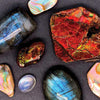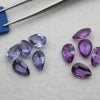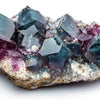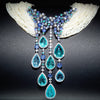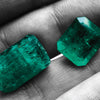Rubies and Sapphires: Twin Flames of the Gem World
- by Greta Fontanella

Rubies and sapphires have adorned royalty, clergy, and collectors for thousands of years. Their vivid hues, historical mystique, and remarkable durability have placed them among the most sought-after gemstones — but what many don't realize is that these iconic stones are actually two varieties of the same mineral: corundum.
What Are Rubies and Sapphires?
Both rubies and sapphires belong to the corundum family, composed of aluminum oxide (Al₂O₃). The presence of trace elements in this otherwise colorless mineral is what gives rise to their vivid hues:
-
Chromium creates red, turning corundum into a ruby.
-
Iron and titanium yield blue sapphires.
-
Other elements like vanadium, magnesium, or more iron create every other shade.
This means that sapphires come in every color except red — because once red enters the equation, we call it a ruby.
The Ruby: Passion Encapsulated in a Stone
The ruby's deep red hue has been associated with life force, courage, and love since ancient times. Known as the “King of Gemstones” in many cultures, rubies were believed to hold protective powers and even stimulate the heart.
The most prized rubies are:
-
Pigeon Blood Rubies: A pure, saturated red with a slight bluish undertone, often from Burma (Myanmar).
-
Unheated Rubies: Untreated rubies retain their natural color and command a higher value.
Rubies are especially valued for their fluorescence, which can make the stone appear to glow from within.
The Sapphire: Wisdom in Every Hue
The name sapphire often evokes a rich royal blue — the classic choice for engagement rings and royal jewelry. However, sapphires exist in a full spectrum, including:
-
Pink, green, orange, purple, yellow, white
-
Padparadscha sapphires: a rare and coveted blend of pink and orange
-
Color-change sapphires: shifting between blue and violet under different light
In ancient Persia, it was believed that the sky was painted blue by the reflection of a giant sapphire. Blue sapphires are associated with wisdom, loyalty, and divine favor.
Treatments, Origins, and Value
Most sapphires and rubies on the market have been heat-treated to enhance color and clarity. This is standard and accepted, but untreated stones with strong color and minimal inclusions fetch premium prices.
Major sources include:
-
Rubies: Myanmar, Mozambique, Thailand
-
Sapphires: Sri Lanka, Kashmir, Madagascar, Australia, Montana (USA)
The Gray Area: Ruby vs Pink Sapphire
One of the most complex distinctions in gemology is where ruby ends and pink sapphire begins. In some countries, such as the U.S., lighter reddish-pink stones are classified as pink sapphires, while in others (notably some parts of Asia), they may still be considered rubies. It often comes down to chromium concentration, tone, and even market preferences.
Symbolism and Legacy
Rubies and sapphires have long been used in talismans, royal regalia, and engagement rings. Their symbolic power includes:
-
Rubies: Passion, energy, and protection
-
Sapphires: Wisdom, truth, and fidelity
Whether worn as an amulet or admired for their rarity, these “twins” of corundum offer timeless allure.
- Posted in:
- birthstones
- corundum
- gemstone colors
- gemstone history
- gemstone symbolism
- padparadscha
- pink sapphire vs ruby
- rare sapphires
- ruby
- sapphire

